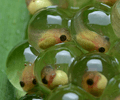Tadpole facts for kids
A tadpole or polliwog is a young frog or toad that lives in the water. They hatch from tiny eggs laid by their mother, usually in a pond or lake. Tadpoles are an important part of the life cycle of amphibians.
Contents
What is a Tadpole?
Tadpoles are the baby stage of frogs and toads. They look very different from adult frogs. Most tadpoles have a round body, a long tail, and no legs. They breathe using gills, just like fish. They swim by wiggling their tails from side to side.
Frog and Toad Eggs
Frog eggs are often found in round clumps, floating in the water. Toad eggs are laid in long, string-like chains. Each egg contains enough food for the tadpole to grow for about 21 days.
The Tadpole Life Cycle
The journey from a tiny egg to an adult frog is amazing! It involves many changes called metamorphosis.
Hatching and Early Life
After hatching, a tadpole is very small. It spends its first few weeks eating and growing. Most tadpoles eat only plants, like algae. Some types can eat both plants and small animals, including other tiny tadpoles.
Growing Legs
After a few weeks, tadpoles start to grow their back legs first. Then, their front legs begin to appear. As their legs grow, their bodies also start to change.
Losing the Tail and Breathing Air
Soon, the tadpole's lungs start to develop. This means they can begin to breathe air, just like adult frogs. At this stage, they often swim near the water's surface. Slowly, their long tail gets shorter and shorter until it disappears completely. This happens because the tail cells are naturally absorbed by the body.
Becoming a Froglet
When the tail is gone, the tadpole is now called a froglet. It looks like a tiny version of an adult frog. Its mouth also changes, becoming wider. Its insides, like its intestines, get shorter to help it digest its new diet. Froglets are ready to leave the water and live on land.
Reaching Adulthood
Froglets continue to grow larger. In a few months, they will become full-grown adult frogs or toads. Then, they can lay their own eggs and start the life cycle all over again!
Images for kids
-
The anatomy of a wood frog tadpole (Lithobates sylvaticus)
See also
 In Spanish: Renacuajo para niños
In Spanish: Renacuajo para niños







